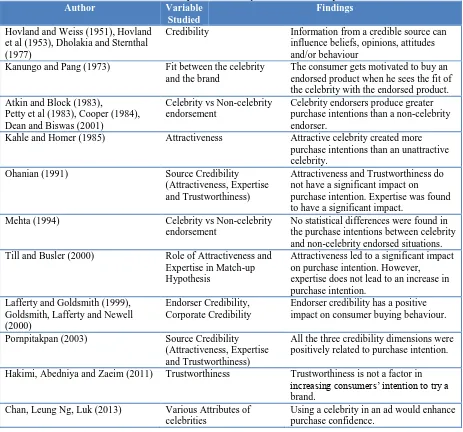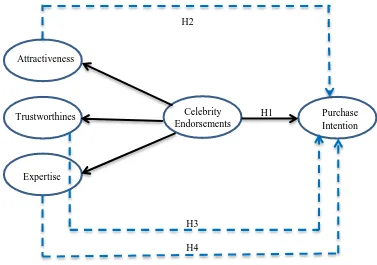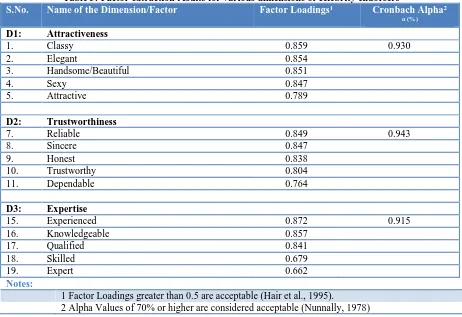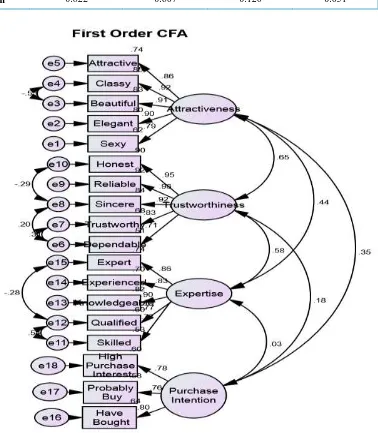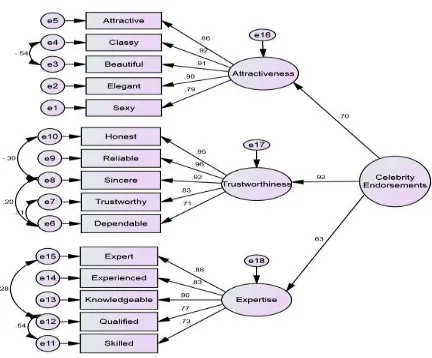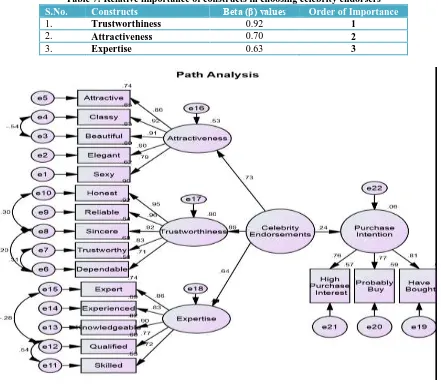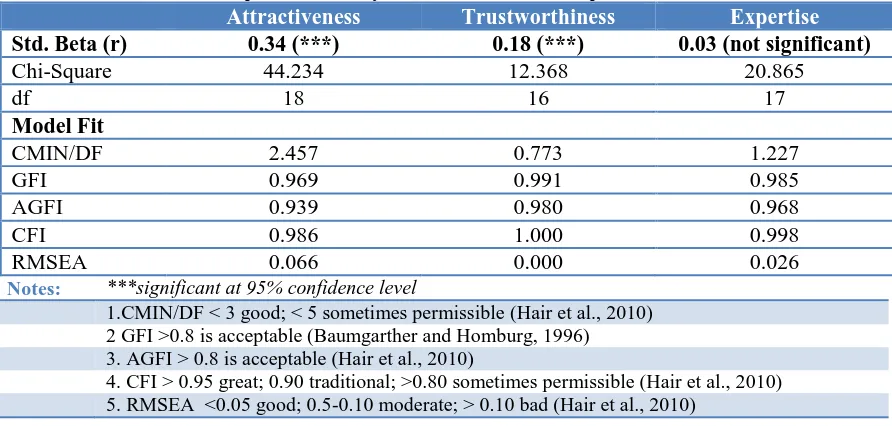IMPACT OF CELEBRITY ENDORSEMENTS ON CONSUMERS’ PURCHASE INTENTION: A Study of Indian Consumers
Ruchi Gupta
Assistant Professor, Department of Commerce, Shaheed Bhagat Singh College, University of Delhi, India. ruchigupta.sbsc@gmail.com
Nawal Kishore
Professor, School of Management Studies, Indira Gandhi National Open University, New Delhi, India. nkishore@ignou.ac.in
DPS Verma
Former Professor, Department of Commerce, Delhi School of Economics, University of Delhi, India. dpsverma@hotmail.com
ABSTRACT
The use of celebrity endorsements in advertising has become a trend and a perceived winning formula of corporate image building and product marketing. As existing media get increasingly cluttered, the need to stand out has become paramount and celebrities have proved to be the ideal way to ensure brand prominence. Research has shown that the use of celebrity endorsers brings many positive effects in terms of positive feelings towards the ad and the brand, a positive brand attitude and increased purchase intention for the brand. Numerous researches have proved empirically the effectiveness and the positive influence of celebrity endorsements in advertising, particularly on purchase intention. However, there is no common consensus on whether attractiveness, trustworthiness and expertise of the celebrity endorsers have a significant impact on consumers’ purchase intention. Through a survey of 336 Indian respondents who are exposed to celebrity endorsements for various products/brands, the present study attempts to find out the impact of celebrity endorsements on consumers’ purchase intention. The three-dimensional scale proposed by Roobina Ohanian (1990) has been used for the purpose. Thus, the present study considers three attributes of celebrity endorsements as suggested by Ohanian - attractiveness, trustworthiness and expertise. The study also attempts to find out the individual impact of these dimensions on consumers’ purchase intention. Exploratory factor analysis was used to reconfirm the factor structure. The model used was empirically tested for unidimensionality, reliability, convergent validity and discriminant validity, using confirmatory factor analysis. Structural equation modeling was used to find out the impact of celebrity endorsements on purchase intention. Results reveal that celebrity endorsements have a significant impact on consumers’ purchase intention. However, the beta coefficients reveal a low degree of correlation between celebrity endorsements and purchase intention. Further, attractiveness and trustworthiness are found to have a significant impact on the purchase intention, while expertise did not have a significant impact on purchase intention.
Keywords: celebrity endorsements, purchase intention, exploratory factor analysis, confirmatory factor analysis, structural equation modelling
JEL Classification: M31, M37
INTRODUCTION
The use of celebrity endorsements in advertising has become a trend and a perceived winning formula of corporate image building and product marketing. As existing media get increasingly cluttered, the need to stand out has become paramount and celebrities have proved to be the ideal way to ensure brand prominence.
Celebrity - Concept and Meaning
Celebrities are people who enjoy public recognition and who often have distinctive attributes such as attractiveness and trustworthiness (McCracken, 1989; Silvera and Austad, 2004).
The term ‘celebrity’ refers to an individual who is known to the public, such as actors, sport figures, entertainers and others for their achievements in their respective areas other than the product endorsed by them (Friedman and Friedman, 1979).
Celebrity Endorser
McCracken (1989) defined celebrity endorser as “any individual who enjoys public recognition and who uses this recognition on behalf of a consumer good by appearing with it in an advertisement”.
Kamins (1989), defined celebrity endorser as “an individual who is known to the public for his or her achievements in areas other than that of the product endorsed”. Stafford et al., (2003) gave a clear definition by defining celebrity endorser as, “a famous person who uses public recognition to recommend or co-present with a product in an ad”.
Celebrity Endorsement
‘Celebrity endorsements’ has been accepted to be a ‘ubiquitous’ feature of modern day marketing (McCracken 1989). It has the potential to enhance audience attentiveness, make the ad more memorable, credible, and desirable and add glamour to the endorsed product (Spielman, 1981). Today celebrity endorsement has become an integral part of the advertisement industry. In fact, celebrity endorsements are omnipresent feature of present day marketing. This holds true for the Indian perspective as well (O’Mahony, 1998). Celebrities are increasingly being used by marketers to get attention and recall of the consumers. Not only this, the marketers expect their brands to benefit in many more ways by linking their brands to the celebrities.
Purchase Intention
Purchase intentions are personal action tendencies relating to the brand (Bagozzi et al., 1979; Ostrom, 1969). Intentions are distinct from attitudes. Whereas attitudes are summary evaluations, intentions represent “the person’s motivation in the sense of his or her conscious plan to exert effort to carry out a behaviour” (Eagly and Chaiken, 1993). Thus, a concise definition of purchase intentions may be as follows:
Purchase intentions are an individual’s conscious plan to make an effort to purchase a brand. (Spears and Singh, 2004)
Atkin and Block (1983) and Petty et. al. (1983) found that as compared to the non-celebrity endorsers, the celebrity endorsers produced more positive attitudes towards advertising and greater purchase intentions. Many studies have proved that celebrity endorsements are likely to have a positive effect on consumer buying behaviour (Goldsmith, Lafferty and Newell 2000; Mathur, Mathur & Rangan, 1997).
REVIEW OF LITERATURE
“Celebrity is an omnipresent feature of society, blazing lasting impressions in the memories of all who cross its path.” (Kurzman, et al., 2007). Celebrities are often hired by advertisers to lend their personality to a product or brand (Kaikati, 1987). The use of celebrities has been widely used as it could provoke attitudinal and emotional reactions (Kanungo and Pang, 1973) than a non-celebrity endorser (Atkin & Block, 1983; Petty and Cacioppo, 1983). In order to be effective a celebrity endorser should have the credibility to attract attention (Miciak and Shanklin, 1994) increase awareness of the endorsed product and influence the purchase decision of the targeted audience (Ohanian, 1991).
Atkin and Block (1983) and Petty et. al (1983) found that as compared to the non-celebrity endorsers, the celebrity endorsers produced more positive attitudes towards advertising and greater purchase intentions. The vehicle most often used to associate celebrities with a chosen product is advertising; where celebrities are known to induce more positive feelings toward ads than non-celebrity endorsers (Atkin & Block, 1983; Kamins, 1990; O'Mahony & Meenaghan, 1998).
Numerous researches have proved empirically the effectiveness and the positive influence of the endorsements by the celebrities in advertising, particularly on endorser's credibility, message reminder, announcements approval and purchase intention (Menon, 2001; Pornpitakpan, 2003; Pringle and Binet, 2005; Roy, 2006).
All these arguments lead to the conclusion that celebrity endorsements are likely to have a positive effect on consumer buying behaviour (Goldsmith, Lafferty and Newell 2000; Mathur, Mathur & Rangan, 1997).
Table 1 lists various studies, along with their research findings, conducted to find the impact of celebrity endorsements on consumer’s purchase intentions.
Table 1: Studies conducted on impact of celebrity endorsements on purchase intentions
Author Variable
Studied
Findings
Hovland and Weiss (1951), Hovland et al (1953), Dholakia and Sternthal (1977)
Credibility Information from a credible source can influence beliefs, opinions, attitudes and/or behaviour
Kanungo and Pang (1973) Fit between the celebrity and the brand
The consumer gets motivated to buy an endorsed product when he sees the fit of the celebrity with the endorsed product. Atkin and Block (1983),
Petty et al (1983), Cooper (1984), Dean and Biswas (2001)
Celebrity vs Non-celebrity endorsement
Celebrity endorsers produce greater purchase intentions than a non-celebrity endorser.
Kahle and Homer (1985) Attractiveness Attractive celebrity created more purchase intentions than an unattractive celebrity.
Ohanian (1991) Source Credibility (Attractiveness, Expertise and Trustworthiness)
Attractiveness and Trustworthiness do not have a significant impact on purchase intention. Expertise was found to have a significant impact.
Mehta (1994) Celebrity vs Non-celebrity endorsement
No statistical differences were found in the purchase intentions between celebrity and non-celebrity endorsed situations. Till and Busler (2000) Role of Attractiveness and
Expertise in Match-up Hypothesis
Attractiveness led to a significant impact on purchase intention. However, expertise does not lead to an increase in purchase intention.
Lafferty and Goldsmith (1999), Goldsmith, Lafferty and Newell (2000)
Endorser Credibility, Corporate Credibility
Endorser credibility has a positive impact on consumer buying behaviour.
Pornpitakpan (2003) Source Credibility (Attractiveness, Expertise and Trustworthiness)
All the three credibility dimensions were positively related to purchase intention.
Hakimi, Abedniya and Zaeim (2011) Trustworthiness Trustworthiness is not a factor in increasing consumers’ intention to try a brand.
Chan, Leung Ng, Luk (2013) Various Attributes of celebrities
Using a celebrity in an ad would enhance purchase confidence.
Gap Analysis
Most of the research studies conducted in the past have found a positive impact of celebrity endorsements on consumers’ purchase intentions. However, the earlier studies have been conducted in different countries and consumer groups. The present study seeks to find out the impact of celebrity endorsements on purchase intentions of Indian consumers. It shall be interesting to see whether similar results are seen in the present study also.
these variables do not have an impact on purchase intention. Thus, the paper also aims to find out the impact of each of the celebrity attributes - attractiveness, trustworthiness and expertise - on consumer’s purchase intentions. It would be interesting to note how the results of attractiveness, trustworthiness and expertise relate to the previous researches done on the topic.
Objectives of the Study
The present study aims to find out:
i. The impact of celebrity endorsements on purchase intention of the consumers;
ii. The impact of attractiveness of celebrity endorsers on purchase intention of consumers; iii. The impact of trustworthiness of celebrity endorsers on purchase intention of consumers; and iv. The impact of expertise of celebrity endorsers on purchase intention of consumers.
Theoretical Model for the Proposed Study
Figure 1: Theoretical model for the study
Hypotheses of the Proposed Study
H1: Celebrity endorsements do not have a significant impact on consumers’ purchase intention H2: Attractiveness of celebrities does not have a significant impact on consumers’ purchase intention H3: Trustworthiness of celebrities does not have a significant impact on consumers’ purchase intention H4: Expertise of celebrities does not have a significant impact on consumers’ purchase intention
RESEARCH METHODOLOGY Research Design
Observations from the literature helped in designing of the survey instrument by careful selection of items for measuring the various constructs. This was followed by pre-testing of the instrument by professionals and academicians to establish content validity. After this, the instrument was pre-tested objectively through a pilot study, which was conducted with a small sample size of 50. The respondents provided comments on clarity of some items and confirmed face validity of items in the questionnaire. After modification, refinement and finalisation of the instrument, data were collected from the respondents.
The present study intended to collect responses from about 500 respondents from Delhi/NCR area of India. Convenience and judgemental sampling methods were used to collect data from the customers. Of the 500 questionnaires distributed to the respondents, 362 questionnaires were received. On further filtering 336 responses were found to be completely filled.
H4 H3 Celebrity Endorsements
Purchase Intention
Expertise Trustworthines
s Attractiveness
Design of Survey Instrument
Primary data were collected from respondents through a questionnaire. In the first part of the questionnaire, items for the three dimensions of celebrity endorsers given by Ohanian (namely, attractiveness, trustworthiness and expertise) were included. The study employed fifteen items under the three constructs given by Ohanian – attractiveness, trustworthiness and expertise. Each of these items was evaluated on a seven-point Likert scale ranging from 1: “Strongly Disagree” to 7: “Strongly Agree”. The second part of the questionnaire included 3 questions evaluated on a seven-point Likert scale ranging from 1: “Strongly Disagree” to 7: “Strongly Agree”. These intended to measure consumers’ purchase intention in response to celebrity endorsements.
The present study used Exploratory Factor Analysis (EFA), Confirmatory Factor Analysis and Structural Equation Modeling (SEM) to retest the previously validated scale, to assess reliability and validity and to find out the impact of celebrity endorsements on consumers’ purchase intention.
Analysis and Results
Data collected were analysed through a series of validated tools and procedures. A critical step involved in the development of a measurement scale is to assess the reliability of constructs. For this purpose, Cronbach alpha was calculated. This was followed by conducting exploratory factor analysis to reconfirm the factor structure as given by Ohanian (1990). Confirmatory factor analysis was used to establish convergent and discriminant validity. Further, stuctural equation modeling was used to find out the impact of celebrity endorsements on consumers’ purchase intention. The results of the aforesaid analyses are described in the following sub-sections.
Assessment of Reliability
The reliability of the items was assessed by computing the coefficient alpha (Cronbach, 1951). Cronbach alpha measures the internal consistency or reliability of items. For a measure to be acceptable, Cronbach alpha should be above 0.7 (Nunnally, 1978). Owing to the multidimensionality of ‘Celebrity Endorsements’, Cronbach alpha was computed separately for all the constructs identified under the common construct ‘celebrity endorsements’. In the present study, all alpha coefficients calculated for the three celebrity attributes were above 0.9, indicating good consistency among the items within each dimension. These alpha coefficients are provided in Table 3. The Cronbach alpha calculated for the impact variable ‘purchase intention’ was 0.788 (Table 4). Also, the Cronbach alpha calculated for all the 18 Likert scale questions was 0.923 which indicated the reliability of the survey instrument.
Exploratory Factor Analysis
Exploratory factor analysis was conducted to reconfirm the factor structure given by Ohanian (1990). Before conducting factor analysis, one needs to determine whether it is appropriate to conduct factor analysis. This can be done by examining the sampling adequacy through Kaiser-Meyer-Olkin (KMO) statistic. Also, Bartlett's test of sphericity measures whether there are correlations in the data set that are appropriate for factor analysis. Table 2 provides the SPSS output for the KMO statistic and Bartlett’s test of sphericity.
Table 2: KMO and Bartlett's test results
Kaiser-Meyer-Olkin Measure of Sampling Adequacy .923
Bartlett's Test of Sphericity Approx. Chi-Square 4951.108 df 105
Sig. .000
Notes:
KMO = 0.90-marvelous, in the 0.80's-meritorious, in the 0.70's-middling, in the 0.60's-mediocre, in the 0.50's-miserable, and below 0.50-unacceptable (Kaiser, 1974)
Bartlett's test of sphericity tests the hypothesis that the correlation matrix is an identify matrix; i.e. all diagonal elements are 1 and all off-diagonal elements are 0, implying that all of the variables are uncorrelated. If the significance value for this test is less than our alpha level, we reject the null hypothesis that the population matrix is an identity matrix. The significance value for this analysis leads us to reject the null hypothesis and conclude that there are correlations in the data set that are appropriate for factor analysis. This analysis meets this requirement.
After running factor analysis, three factors (Attractiveness, Trustworthiness and Expertise) comprising fifteen items were extracted and the results are shown in Table 3. Further, in order to assess the appropriateness of the data for factor analysis, the communalities derived from the factor analysis were reviewed. These were all relatively large (greater than 0.6), suggesting that the data set is appropriate (Stewart, 1981). Thus, the factor structure given by Ohanian (1990) was reconfirmed for the present data set.
Table 3: Factor extraction results for various dimensions of celebrity endorsers
S.No. Name of the Dimension/Factor Factor Loadings1 Cronbach Alpha2
α (%)
D1: Attractiveness
1. Classy 0.859 0.930
2. Elegant 0.854
3. Handsome/Beautiful 0.851
4. Sexy 0.847
5. Attractive 0.789
D2: Trustworthiness
7. Reliable 0.849 0.943
8. Sincere 0.847
9. Honest 0.838
10. Trustworthy 0.804
11. Dependable 0.764
D3: Expertise
15. Experienced 0.872 0.915
16. Knowledgeable 0.857
17. Qualified 0.841
18. Skilled 0.679
19. Expert 0.662
Notes:
1 Factor Loadings greater than 0.5 are acceptable (Hair et al., 1995).
2 Alpha Values of 70% or higher are considered acceptable (Nunnally, 1978)
Confirmatory Factor Analysis
According to Ahire, Golhar and Waller (1996), confirmatory factor analysis (CFA) provides enhanced control for assessing unidimensionality as compared to exploratory factor analysis (EFA) and is more in line with the overall process of construct validation. Unidimensionality refers to the extent to which the items on a factor measure one single construct. In the present study, CFA was run using AMOS 19.
First, zero-order CFA was done for all the three constructs – Attractiveness, Trustworthiness and Expertise. Thereafter, zero order CFA was done for the impact variable ‘Purchase Intention’. The results of zero-order CFA for the said constructs are given in Table 4.
After this, first-order CFA was conducted. The results of the same are given in Table 5. Thereafter, second-order CFA was conducted. During the course of this analysis, convergent and discriminant validity were also established, as explained in the next section.
Validity Analysis
Some of the important validity issues generally considered include content validity and construct validity (including convergent validity and discriminant validity).
Content Validity
Construct Validity
Construct validity involves the assessment of the degree to which an operationalization correctly measures its targeted variables (O’Leary-Kelly and Vokurka, 1998). According to O’Leary-Kelly and Vokurka, establishing construct validity involves the empirical assessment of unidimensionality, reliability and validity (convergent and discriminant validity). In order to check for unidimensionality in the present study, a measurement model was specified for each construct and CFA (zero-order) was run for all the four constructs - Attractiveness, Trustworthiness, Expertise and Purchase Intention. Individual items in the model were examined to see how closely they represent the same construct. A comparative fit index (CFI) of 0.9 or more for the model implies that there is a strong evidence of unidimensionality (Byrne, 1994). The CFI values obtained for the four constructs are above 0.9 as shown in Table 4. This indicates a strong evidence of unidimensionality for the scale. Once unidimensionality and reliability of a scale is established, it is further subject to validity analysis (Ahire, Golhar and Waller, 1996).
Convergent validity can be established if two similar constructs correspond with one another, while discriminant validity applies to two dissimilar constructs that are easily differentiated.
(a) Convergent Validity
To establish convergent validity, one needs to show that measures that should be related are in reality related. The convergent validity of a construct is established when the following three conditions are met (Hair, Black, Babin and Anderson, 2010).
Cronbach Alpha > 0.7
AVE(Average Variance Extracted) > 0.5 and Cronbach Alpha > AVE
The ‘Average Variance Extracted’ measures the amount of variance that is captured by the construct in relation to the amount of variance due to measurement error. It can be calculated by taking the square of the average of standardised regression coefficients. If the average variance extracted is less than .50, then the variance due to measurement error is greater than the variance due to the construct. In this case, the convergent validity of the construct is questionable.
In the present study, convergent validity is calculated for the zero-order, first-order and second-order models. The results of zero order CFA given in Table 4 show that all three conditions of convergent validity are met. Therefore, convergent validity is established for the zero-order CFA for all the constructs. Table 5, which provides results for the first-order CFA, also shows that these three conditions are satisfied. Thus, convergent validity is established for the first order model. Also, for the second-order CFA, α= 0.939 and AVE= 0.703. Thus, convergent validity is established for the second-order model also.
Table 4: Zero-order CFA results
Constructs Cronbach
Alpha (α)1
AVE Is α > AVE CFI2 GFI3
Attractiveness 0.930 0.765 Yes 0.999 0.993
Trustworthiness 0.943 0.757 Yes 1.000 0.997
Expertise 0.915 0.668 Yes 0.997 0.992
Purchase Intention 0.788 0.606 Yes 1.000 1.000
Notes:
1. Alpha Values of 70% or higher are considered acceptable (Nunnally, 1978) 2. CFI value of 0.9 and above testifies strong unidimensionality (Byrne, 1994) 3. GFI value of more than 0.9 shows best fit of model (Joreskog and Sorbom, 1990)
(b) Discriminant Validity
To establish discriminant validity, one needs to show that measures that should not be related are in reality not related. Discriminant validity is ensured if a measure does not correlate very highly with other measures from which it is supposed to differ (O’Leary-Kelly and Vokurka, 1998). In the present study, discriminant validity will be calculated only for the first-order model. It cannot be calculated for the zero-order and second-order model. The discriminant validity of a construct is established when the following two conditions are met (Hair, Black, Babin and Anderson, 2010).
It is clear from Table 5 which provides the first-order CFA results that the two conditions of discriminant validity are satisfied and thus, discriminant validity is established for the said model.
Table 5: First order CFA results
Construct Cronbach Alpha
(α)
AVE MSV ASV
Attractiveness 0.943 0.771 0.419 0.379
Trustworthiness 0.943 0.768 0.419 0.308
Expertise 0.912 0.675 0.339 0.268
Purchase Intention 0.822 0.607 0.120 0.051
Figure 3: Second order CFA
Testing Goodness of Fit
The following models were tested for goodness of fit. 1. First-order CFA model
2. Second-order CFA model
The overall fit indices for these models are given in Table 6. One must note that a good fit between the model and the data does not mean that the model is “correct”, or even that it explains a large proportion of the covariance. A “good model fit” only indicates that the model is plausible (Schermelleh-Engel, K.,Moosbrugger, H., & Müller, H. (2003).
Table 6: Overall fit indices for first order and second order CFA
Model Element First-order CFA Model Second-order CFA Model
Chi-Square (λ2) 312.187 249.839
Degrees of Freedom (df) 123 81
Model Fit
CMIN/DF (λ2/df) 2.538 3.084
GFI 0.910 0.913
AGFI 0.875 0.872
CFI 0.965 0.966
Notes:
1.CMIN/DF < 3 good; < 5 sometimes permissible (Hair et al., 2010) 2 GFI >0.8 is acceptable (Baumgarther and Homburg, 1996)
3. AGFI > 0.8 is acceptable (Baumgarther and Homburg, 1996)
4. CFI > 0.95 great; 0.90 traditional; >0.80 sometimes permissible (Hair et al., 2010) 5. RMSEA <0.05 good; 0.5-0.10 moderate; > 0.10 bad (Hair et al., 2010)
As is clear from Table 6, the various fit indices for the said models are in the acceptable range. This means that the said models are a good fit. In other words, we may say that the said models are acceptable.
Relative Importance of Factors in Choosing Celebrity Endorsers
Table 7 shows the beta (β) values of the three constructs-attractiveness, trustworthiness and expertise (obtained from second order CFA), indicating their order of importance in making a choice of a celebrity endorser. Thus, trustworthiness of the celebrity is the most important factor in making a choice of a celebrity endorser. This is followed by attractiveness and expertise, in that order, in deciding who should be the celebrity endorser for the product/brand.
Table 7: Relative importance of constructs in choosing celebrity endorsers
S.No. Constructs Beta (β) values Order of Importance
1. Trustworthiness 0.92 1
2. Attractiveness 0.70 2
3. Expertise 0.63 3
Table 8: Impact of celebrity endorsements on purchase intention and model fit
Model Element
Impact on Consumer Purchase Intention
Standardised Beta (r)
0.24(***)
Chi-Square (λ
2)
337.274
Degrees of Freedom (df)
125
Model Fit
CMIN/DF (λ
2/df)
2.698
GFI
0.903
AGFI
0.867
CFI
0.960
RMSEA
0.071
Notes: ***significant at 95% confidence level
1.CMIN/DF < 3 good; < 5 sometimes permissible (Hair et al., 2010) 2 GFI >0.8 is acceptable (Baumgarther and Homburg, 1996)
3. AGFI > 0.8 is acceptable (Hair et al., 2010)
4. CFI > 0.95 great; 0.90 traditional; >0.80 sometimes permissible (Hair et al., 2010) 5. RMSEA <0.05 good; 0.5-0.10 moderate; > 0.10 bad (Hair et al., 2010)
Table 8 reveals that celebrity endorsements have a significant impact on consumers’ purchase intention. This is because standardised beta figure is found to be significant at 95% confidence level. Therefore, H1 is rejected. This means that using celebrity endorsements in marketing communications can help a marketer to improve the purchase intention for the brand/product in question. However, there exists low degree of correlation between celebrity endorsements and their impact on consumers’ purchase intention. The table also shows various fit indices for the model used to determine the impact of celebrity endorsements on the impact variable ‘purchase intention’. As is clear from Table 8, the various fit indices for the said model are in the acceptable range. This means that the said model is a good fit. In other words, we may say that the said model is acceptable. Thus, our proposed model passes the test of goodness of fit and can be considered an acceptable model for finding out the impact of celebrity endorsers on purchase intention.
Table 9: Impact of celebrity attributes on consumer purchase intention
Attractiveness
Trustworthiness
Expertise
Std. Beta (r)
0.34 (***)
0.18 (***)
0.03 (not significant)
Chi-Square
44.234
12.368
20.865
df
18
16
17
Model Fit
CMIN/DF
2.457
0.773
1.227
GFI
0.969
0.991
0.985
AGFI
0.939
0.980
0.968
CFI
0.986
1.000
0.998
RMSEA
0.066
0.000
0.026
Notes: ***significant at 95% confidence level
1.CMIN/DF < 3 good; < 5 sometimes permissible (Hair et al., 2010) 2 GFI >0.8 is acceptable (Baumgarther and Homburg, 1996)
3. AGFI > 0.8 is acceptable (Hair et al., 2010)
4. CFI > 0.95 great; 0.90 traditional; >0.80 sometimes permissible (Hair et al., 2010) 5. RMSEA <0.05 good; 0.5-0.10 moderate; > 0.10 bad (Hair et al., 2010)
coefficients in the celebrity endorsement scale also ranked trustworthiness and attractiveness as the most important dimensions in the choice of a celebrity endorser. Thus, the marketers may make a note of this point while making a choice of the celebrity endorser.
DISCUSSION AND FINDINGS
Previous research on celebrity endorsement reveals that celebrity endorsers produced more positive attitudes towards advertising and greater purchase intentions than a non-celebrity endorser (Atkin and Block 1983; Petty et al. 1983; Ohanian 1991). Many researchers believe that an advertisement featuring a celebrity delivers a higher degree of appeal, attention, recall rate and possibly purchase compared to the ads without celebrities (Cooper, 1984; Dean and Biswas, 2001). Different studies have used different dimensions of a celebrity endorser to find out the said impact.
The present study employed exploratory factor analysis, confirmatory factor analysis and structural equation modeling to find out the impact of celebrity endorsements on consumers’ purchase intention. For assessing the impact of celebrity endorsements on the said dimension, a three-dimensional celebrity endorsement scale proposed by Ohanian (1990) was used. The survey instrument contained 18 Likert scale questions in all. The survey instrument demonstrated high reliability and validity.
The results of the study revealed that celebrity endorsements have a significant impact on consumers’ purchase intention. However, as revealed by the beta coefficient (r), there exists a low degree of correlation between the two. These results are in line with the results obtained by various earlier researchers like McGuire (1985), Hovland and Weiss (1951), Atkin and Block (1983),Petty et al. (1983), Cooper (1984), Dean and Biswas (2001), Pornpitakpan (2003) and Chan, Leung Ng, Luk (2013).
Further, it was proved that attractiveness and trustworthiness of a celebrity endorser have a significant impact on consumers’ purchase intention. However, expertise of a celebrity endorser does not significantly impact consumers’ purchase intention. It shall be interesting to note that these results are extremely opposite to those obtained by Ohanian (1991) where she found that attractiveness and trustworthiness of a celebrity endorser do not have a significant impact on purchase intention, whereas, expertise was found to have a significant impact. Hakimi, Abedniya and Zaeim (2011) concluded that trustworthiness is not a factor in increasing consumers’ intention to try a brand. However, the results of the present study are in line with those of some earlier researches like McGuire (1985), Hovland and Weiss (1951), Kamins and Gupta (1994), McCracken (1986), Atkin and Block (1983), Kanungo and Pang (1973) and Pornpitakpan (2003). Till and Busler (2000) also concluded that ‘expertise’ does not lead to an increase in purchase intention.
Thus, the findings of the present study reveal that celebrity endorsements can be an effective marketing tool available to the marketers as it is expected to have a significant positive impact on consumers’ purchase intentions. These positive purchase intentions can be converted to purchase if other factors in the marketing mix are carefully planned. Thus, the strategy of using celebrity endorsements may contribute towards a positive financial return for the companies (Farrell, et al., 2000, Erdogan, 2001).
Managerial Implications of the Study
The major managerial implications of the study include the following:
1. The present study provides directions to the marketing managers as to which particular dimension of a celebrity endorser requires more consideration in terms of its importance while making a choice. The study indicated that from among the various dimensions of celebrity endorsers, trustworthiness of the celebrity should be the most important factor in making a choice of a celebrity endorser. This should be followed by attractiveness and expertise in that order.
2. The findings of the present study reveal that celebrity endorsements can be an effective marketing tool available to the marketers as it is expected to have a significant positive impact on consumers’ purchase intentions. These positive purchase intentions can be converted to purchase if other factors in the marketing mix are carefully planned.
Limitations of the Study and Directions for Future Research
While significant findings are obtained from the study, certain limitations are inherent in it, which may provide direction for future exploration. Some of the key areas for future research include the following.
The instrument is developed and validated by collecting the data from 336 customers in Delhi/NCR. A study may be conducted to accommodate the perception of consumers living in various parts of India to have a comprehensive view.
The future studies may explore these results for other developing and developed economies as there is a possibility of cultural differences playing a role in the outcome of the study. This may provide a comprehensive understanding of the impact of celebrity endorsers on consumers across different cultures. Future research may find out the moderating influences of age and gender on the impact of celebrity
endorsements on consumers’ purchase intention.
Future research may also investigate the impact of celebrity endorsements on products with varying levels of involvement.
REFERENCES
1. Ahire, S.L.; Golhar, D.Y. and Waller, M.A. (1996). Development and Validation of TQM Implementation Constructs. Decision Sciences, 27(1), 23-56.
2. Assael, Henry (1984). Consumer Behavior and Market Action. Boston, Massachusetts: Kent Publishing Company.
3. Atkin, C. and Block, M. (1983). Effectiveness of Celebrity Endorsers. Journal of Advertising Research, 23, March, 57-61.
4. Bagozzi, Richard P., Alice M. Tybout, C. Samuel Craig, and Brian Sternthal (1979). The Construct Validity of Tripartite Classification of Attitudes. Journal of Marketing Research, 16 (February), 88-95. 5. Baumgarther, H., Homburg, C. (1996). Applications of Structural Equation Modeling in Marketing and
Consumer Research: A Review. International Journal of Research in Marketing, 13(2), 139-161. 6. Bowman, Jo (2002). Facing Advertising Reality. Media Asia, 7(26), 14- 15.
7. Byrne, B. M. (1994). Structural Equation Modeling with EQS and EQS/Windows. Thousand Oaks, CA: Sage Publications.
8. Byrne, Barbara M. Byrne (2010). Structural Equation Modeling with AMOS, Second Edition, Routledge, Taylor and Francis Group, New York, London.
9. Chan, K., Ng, Y.L., and Luk, E. (2013). Impact of Celebrity Endorsement in Advertising on Brand Image among Chinese adolescents. Young Consumers, 14(2), 167-179.
10. Cooper, M. (1984). Can Celebrities Really Sell Products? Marketing and Media Decisions, 12, pp. 64-65.
11. Cronbach, L. J. (1951). Coefficient Alpha and the Internal Structures of Tests. Psychometrika, 16(3), 297-333.
12. Dean, Dwane Hal and Abhijit Biswas (2001). Third-Party Organization Endorsement of Products: An Advertising Cue Affecting Consumer Pre-purchase Evaluation of Goods and Services. Journal of Advertising, 30, 41-57.
13. Dholakia, R.R.and B. Sternthal (1977). Highly Credible Sources Persuasive Facilitators or Persuasive Liabilities. Journal of Consumer Research, 3, 223-32.
14. Eagly, Alice H. and Shelly Chaiken (1993). The Psychology of Attitudes, New York: Harcourt Brace College Publishers.
15. Erdogan, B., Baker, M. & Tagg, S. (2001). Selecting Celebrity Endorsers: The Practitioner’s Perspective. Journal of Consumer Research, 41 (3), 39-48.
16. Erdogan, B.Z. (1999). Celebrity Endorsement: A Literature Review. Journal of Marketing
Management, 15(4), 291-314.
17. Farrell, K.A., Karels, G.V., Monfort, K.W., and McClatchey, C.A. (2000). Celebrity Performance and Endorsement value: The Case of Tiger Woods. Managerial Finance, 26, 1–15.
18. Friedman, H. H. & Friedman, L. (1979). Endorser Effectiveness by Product Type. Journal of Advertising Research, 19 (5), 63-71.
19. Goldsmith, R. E., Lafferty, B. A., & Newell, S. J. (2000). The Impact of Corporate Credibility and Celebrity Credibility on Consumer Reaction to Advertisements and Brands. Journal of Advertising, 29(3), 43.
20. Hair, J F Jr.; Anderson, R E; Tatham, R L and Black, W. C. (1995). Multivariate Data Analysis, 4th ed., Engelwood Cliffs, NJ: Prentice-Hall.
22. Hakimi, B.Y., Abedniya, A. and Zaeim, M.N. (2011). Investigate the Impact of Celebrity Endorsement on Brand Images. European Journal of Scientific Research, 58(1), 116–32.
23. Hovland, C. I., & Weiss, W. (1951). The Influence of Source Credibility on Communication Effectiveness. Public Opinion Quarterly, 15, 635-650.
24. Hovland, C.I, Janis, L.I, & Kelley, H.H. Communication and Persuasion (1953). New Haven, CT: Yale University Press.
25. Joreskog, Karl G., and Dag Sorbom (1990). Model Search with Tetrad II and LISREL, Sociological
Methods and Research, 19, 93-106.
26. Kahle, L. and Homer, P. (1985). Physical Attractiveness of the Celebrity Endorser: A Social Adaptation Perspective. Journal of Consumer Research, 11(4), 954.
27. Kaikati, Jack G. (1987). Celebrity Advertising: A Review and Synthesis. International Journal of Advertising, 6(2), 93-105.
28. Kaiser, H F and Rice, J (1974). Little Jiffy Mark IV. Educational and Psychological Measurement, 34(1), 111-17.
29. Kamins, M.A. (1990). An Investigation into the Match-Up-Hypothesis in Celebrity Advertising when Beauty be Only Skin Deep. Journal of Advertising, 19, No.1, 4-13.
30. Kamins, M.A., (1989). Celebrity and Non-Celebrity Advertising in a Two Sided Context. Journal of Advertising Research, 29(3), 34-42.
31. Kanungo, R. N. and S. Pang (1973). Effects of Human Models on Perceived Product Quality. Journal of Applied Psychology, 57, 172-178.
32. Kurzman, C., Anderson, C., Key, C., lee, Y., Moloney, M., Silver, A., and Van Ryn, M.W. (2007). Celebrity Status. Sociological Theory, 25(4), 347-67.
33. Lafferty ,Barbara A and Goldsmith E. Ronald (1999). Corporate Credibility’s Role in Consumers’ Attitudes and Purchase Intentions When a High versus a Low Credibility Endorser Is Used in the Ad. Journal of Business Research, 44(2), 109-116.
34. Mathur, L.K, Mathur, L., and Rangan, N. (1997). The Wealth Effects Associated with a Celebrity Endorser: The Michael Jordan Phenomenon. Journal of Advertising Research, 37 (May-Jun), 67. 35. McCracken, G. (1989). Who is the Celebrity Endorser? Cultural Foundations of the Endorsement
Process. Journal of Consumer Research, 16, 310-321.
36. Mehta, A. (1994). How Advertising Response Modelling (ARM) Can Increase Ad Effectiveness. Journal of Advertising Research, 34(3), 62-74.
37. Menon, K. (2001). Celebrity Advertising: An Assessment of Its Relative Effectiveness. Mimeo. 38. Miciak, A. R. & Shanklin, W. L. (1994). Choosing Celebrity Endorsers. Marketing Management, 3(3),
51-59.
39. Nunnally, J. C. (1978). Assessment of Reliability. In: Psychometric Theory (2nd ed.), New York: McGraw-Hill.
40. O‘Mahony, S. and Meenaghan, T. (1998). The Impact of Celebrity Endorsement on Consumer. Irish Marketing, 10(2), pp.15, p. 112/113.
41. O’Leary-Kelly, S.W. and Vokurka, R.J. (1998). The Empirical Assessment of Construct Validity.
Journal of Operations Management, 16, 387-405.
42. Ohanian, R. (1990). Construction and Validation of a Scale to Measure Celebrity Endorsers' Perceived Expertise, Trustworthiness and Attractiveness. Journal of Advertising, 19, 39 – 52.
43. Ohanian, R. (1991). The Impact of Celebrity Spokespersons' Perceived Image on Consumers' Intention to Purchase. Journal of Advertising Research, 31(1), 46-52.
44. Ostrom, Thomas M. (1969). The Relationship between the Affective, Behavioral, and Cognitive Components of Attitude. Journal of Experimental Social Psychology, 5, 12-30.
45. Petty, R.E. and Cacioppo J.T. (1983). Central and Peripheral Routes to Persuasion: Application to Advertising. Advertising and Consumer Psychology, eds. Larry Percy and Arch Woodside, Lexington, MA: Lexington Books, 3-23.
46. Pornpitakpan, C. (2003). The Effect of Celebrity Endorsers’ Perceived Credibility on Product Purchase Intention: The Case of Singaporeans. Journal of International Consumer Marketing, 16(2), 55-74. 47. Pringle, H. and Binet, L. (2005). How Marketers Can Use Celebrities to Sell More Effectively. Journal
of Consumer Behaviour, 4(3), 201-214.
48. Roy. S. (2006). An Exploratory Study in Celebrity Endorsements. Journal of Creative Communications, 1(139), 139-153.
49. Rungtusanatham, M .J. (1998). Let’s not Overlook Content Validity. Decision Line, July, 10-13. 50. Schermelleh-Engel, K.,Moosbrugger, H., & Müller, H. (2003). Evaluating the Fit of Structural
51. Silvera, D.H. and Austad, B. (2004). Factors Predicting the Effectiveness of Celebrity Endorsement Advertisements. European Journal of Marketing, 38, 11/12, 1509-1526.
52. Spears, N. & Singh, S. N. (2004). Measuring Attitude toward the Brand and Purchase Intentions. Journal of Current Issues and Research in Advertising, 26(2), 53-66.
53. Spielman, H.M., (1981). The Celebrity Sell: Making it Work. Marketing Times, 28, 13-14.
54. Stafford, M.R., Spears, N.E., Hsu, C.K. (2003). Celebrity Images in Magazine Advertisements: An Application of the Visual Rhetoric Model. Journal of Current Issues & Research in Advertising, 25(2), 13-20.
55. Stewart David W. (1981). Application and Misapplication of Factor Analysis in Marketing Research. Journal of Marketing Research, 18, 51-62.
56. Till, B. and Shimp, T. (1998). Endorsers in Advertising: The Case of Negative Celebrity Information. Journal of Advertising, 27(1), pp.67-82.
